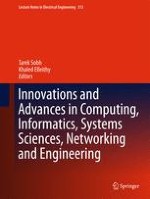2015 | OriginalPaper | Chapter
An Energy Efficient Self-healing Mechanism for Long Life Wireless Sensor Networks
Authors : Dame Diongue, Ousmane Thiare
Published in: Innovations and Advances in Computing, Informatics, Systems Sciences, Networking and Engineering
Publisher: Springer International Publishing
Activate our intelligent search to find suitable subject content or patents.
Select sections of text to find matching patents with Artificial Intelligence. powered by
Select sections of text to find additional relevant content using AI-assisted search. powered by
